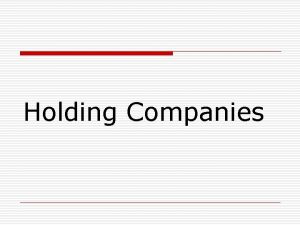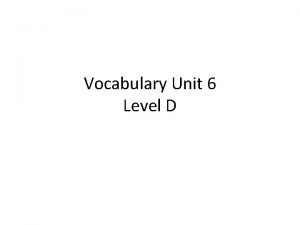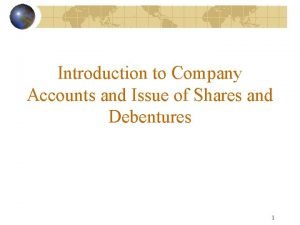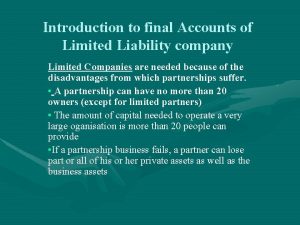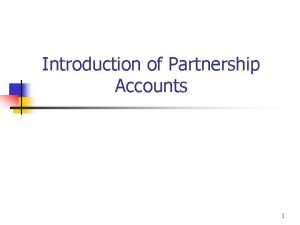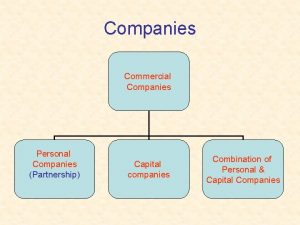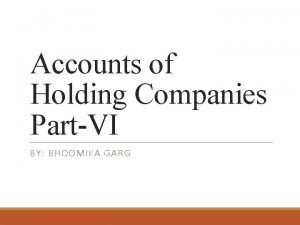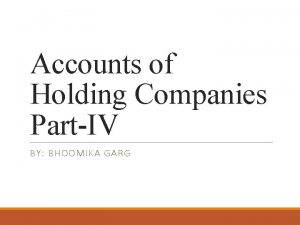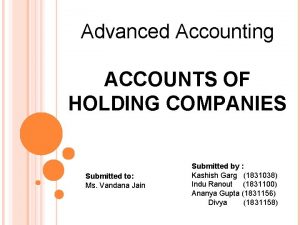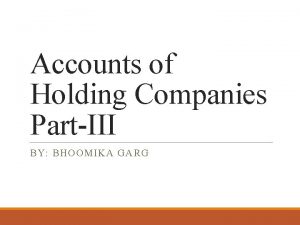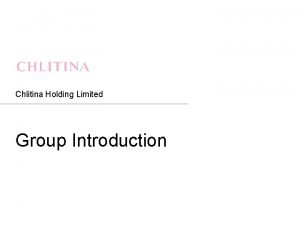TOPIC ACCOUNTS OF HOLDING COMPANIES INTRODUCTION When a
















- Slides: 16

TOPIC : ACCOUNTS OF HOLDING COMPANIES

INTRODUCTION • When a company acquires majority shares in the ownership capital or is in a position to influence or control the management of the other company, the company is called a Holding Company and other company a Subsidiary. • Subsidiaries have their separate existence and are managed by independent governing boards (in case of public enterprises) and Holding company (in case of commercial enterprises). • Holding company is the one that holds either the whole of the share capital or a majority of shares in one or more companies. • Its object is to promote combination movement. • Example = the organization of steel authority of India ltd. etc.

LEGAL DEFINITION A holding company is better defined in the context of definition of a subsidiary company, section 4 of the companies act, 1956 defines a subsidiary company. A company is said to be subsidiary when : (a) That other company controls the composition of its (i. e. subsidiary) Boards of directors or (b) Other (i) when the first mentioned company is an existing company, in respect of which the holders of prefrence shares issued before the commencement of this act have the same voting rights in all respects as the holders of equity shares, exercises or controls more than half of the total voting power of such company. (c) The company is subsidiary of any company which is that other company’s subsidiary.

RATIONALE FOR HOLDING COMPANY • Better quality decisions. • Better utilization of financial and other reserves. • Could promote commercial and managerial culture. • Large number could be reduced to manageable levels. • Concentrate on corporate planning, acquisition and update technology.

CONSOLIDATED BALANCE SHEET • In India, although a holding company is not required by law to prepare a consolidated Balance sheet or a consolidated P & L A/c is of much help to the holding company to show clear pictures. • So, in addition to the ‘legal’ Balance sheet as prescribed in Schedule VI, the holding company may also publish in a consolidated Balance sheet in which the assets and liabilities of all the subsidiaries are given along with its own assets and liabilities as the Balance sheet.

COST OF CONTROL • If the holding company purchases the shares of the subsidiary company at a price which is more than paid-up value of the shares, the excess amount paid represents payment for goodwill or cost of acquiring control of the subsidiary control if there exists no reserves or P & L balance in the subsidiary company on the date of acquisition of shares of the subsidiary company.

PRE-ACQUISITION RESERVES • If there exists some reserves and profits of the subsidiary company on the date of acquisition of shares of the subsidiary company, the outsider share of such reserves and profits is added to the minority interest and the balance of such reserves and profits are capital profits of the Holding company and are shown as capital reserve in the consolidated balance sheet.

REVENUE PROFITS • Profit of the subsidiary company made after the date of the purchase of shares by the holding company are treated as reserve profits. • Holding companies share of such profits is added to the profits of the holding company and share of such profits belonging to the minority shareholders is added to the amount of the minority interest.

MINORITY INTEREST • When some of the shares of the subsidiary company are held by outsiders, their interest, known as the minority interest in the subsidiary company, is calculated and shown on the liabilities side of the Balance Sheet of the holding company. Add : paid up value of the shares Rs. held by outsiders **** Add : proportionate share of the Sub. company’s profits & res. **** Prop. increase in the value of Assets of the sub. co. **** Less : company’s losses *** decrease in value of assets *** Value of Minority interest ****

TREATMENT OF FICTITIOUS ASSETS • Given on the assets side of the balance sheet, • If there, then those items must be deducted from the capital profits or added to the capital loss before distributing the same among the holding company and minority shareholders.

ELIMINATION OF COMMON TRANSACTIONS • 1. 2. 3. Common transactions should be eliminated. Such transactions are : Goods sold on credit by the holding company to the subsidiary company or vice-versa will appear as debtors in the Balance Sheet of the company selling goods and as creditors in the balance sheet of the company purchasing goods. Loans advanced by the HC to the SC or viceversa appears as an asset in the Balance sheet of the company which gives such loans and as a liability in the balance sheet of the company that takes loans. Debentures issued by one company and held by the other company.

TREATMENT OF GOODWILL • Goodwill appearing in the balance sheet of subsidiary company will be shown along with goodwill (if any) of the holding company. • In case there is capital reserve it will be adjusted in Capital reserve on consolidation.

TREATMENT OF UNREALISED PROFIT • If the goods sold at a profit by the subsidiary company to the holding company or vice-versa remain unsold at the close of the financial year, the profit charged by the company on unsold goods remains unrealized. • So, a stock reserve is created and profit is reduced by the unrealised profit.

TREATMENT OF CONTINGENT LIABILITIES • They are shown as follows : 1. Liability in respect of bills discounted not yet matured. It is possible that bills may be discounted on the due date and liability may arise. 2. Amount uncalled on partly paid shares held. 3. Arrears of dividend on Cumulative preference shares.

TREATMENT OF UNCLAIMED DIVIDEND • If unclaimed dividend is given in the Balance Sheet of the subsidiary account, it must the added in full to the total of minority interest in the consolidated balance sheet.

OTHERS • 1. 2. 3. 4. 5. Other than the discussed treatments the following treatments are also to be done, if present : Revaluation of assets and liabilities; Bonus shares; Treatment of dividend; Interim dividend; Treatment of debentures.
 What is subsidiary and holding company
What is subsidiary and holding company Vocabulary workshop level d unit 6
Vocabulary workshop level d unit 6 Example of specific topic
Example of specific topic Topic down
Topic down Chapter 1 introduction to corporate finance
Chapter 1 introduction to corporate finance Company accounts introduction
Company accounts introduction Introduction of final account
Introduction of final account Introduction to final accounts
Introduction to final accounts Introduction to final accounts
Introduction to final accounts Introduction to partnership accounts
Introduction to partnership accounts Company accounts introduction
Company accounts introduction 9-2 tangents
9-2 tangents Waste services lindsay
Waste services lindsay Valuing private companies
Valuing private companies Social media marketing for asset managers
Social media marketing for asset managers Competitive advantage in diversified companies
Competitive advantage in diversified companies People leave bosses not companies
People leave bosses not companies
